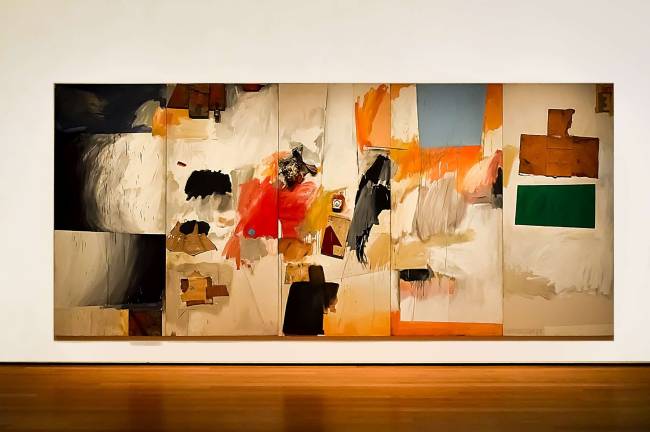Fearless Creativity








BY MARY GREGORY
Don’t be afraid of the Robert Rauschenberg retrospective at MoMA.
While crowds are flocking to the once-in-a-lifetime exhibition that fills the fourth floor of the museum, there are some who might have trepidations. After all, there’s a dead goat in one of the works, for heaven’s sake. There’s also an unmade bed, a cantankerous looking stuffed eagle, a vat of bubbling, molten goop and other possibly off-putting visual messages. Those who love Rauschenberg’s wildly inventive works will love them even more. But art enthusiasts who are on the fence will probably gain the most from the comprehensive, carefully curated and beautifully mounted exhibition.
What we find in “Robert Rauschenberg: Among Friends,” developed in collaboration with London’s Tate Modern and organized by MoMA’s Leah Dickerman, is some 60 years worth of the brilliant output of an extremely collaborative, reciprocally inspiring painter who was also a sculptor, a photographer, a choreographer, a performer, a printmaker, an experimenter with new technologies, a fearless inventor and a creative genius. The exhibition spans Rauschenberg’s entire career and focuses on the way his work fits with others’ while remaining entirely original.
“Curiosity,” Rauschenberg once said, “is probably the most important energy that any creative person can have.” The works in the exhibition bear witness to an endlessly searching mind. But Rauschenberg’s questions don’t seem to be the “what are we here for” kind, rather more “what would happen if I did this?” and “how can I use that?” The whole world provided fodder for his artistic vision. What he encountered in daily life showed up on canvases and “combines,” the term he coined for the groundbreaking multimedia works for which he’s probably best known. Rauschenberg confessed an “insatiable curiosity about everything that I am unfamiliar with” and said he operated in “the gap between art and life.” It was the eternal newness of the world, the unrepeatable nature of experience that he sought to capture and portray.
Born in Texas in 1925, Rauschenberg grew up in a close family that struggled through the Depression. He studied pharmacology and served as a medical technician in the U.S. Navy. In 1947, he went to the Kansas City Art Institute and, in early 1948, departed for studies in Paris, where he met his future wife, the artist Susan Weil. Returning to the U.S. the fall, Rauschenberg then entered Black Mountain College, in North Carolina, a mid-century cauldron of creativity. There he studied under Josef Albers, became friends with the painter Dorothea Rockburne (whose quilt became the iconic “Bed”), as well as Merce Cunningham and John Cage. Weil’s and Rauschenberg’s early photogram collaborations are some of the first images in the exhibition.
The initial gallery features Rauschenberg’s crisp, cool, black-and-white photographs of objects, interiors and artists (Cy Twombly, John Cage and others), assemblages, collages and conceptual paintings that show that even as a student, Rauschenberg was reaching for the unknown. But it’s the work in the following galleries where he breaks free, by dragging the detritus of the city into the studio, repurposing life into art. “I would go out on the streets for everything,” he said. “I spent my time trying to mimic what I saw outdoors.”
The magic of Rauschenberg’s work is that it doesn’t matter if it’s a piece of crumpled metal or a highly polished silkscreen; it’s his voice that comes through, in color, line, proportion and attitude. “Ace,” a glorious, energetic painting filled with light and joy (and an umbrella, a doorknob, fabric, wood and nails) stretches 20 feet. A selection of oil and silk-screen-ink prints on canvas from the ‘60s, capture the flickering blue light of television screens, images of astronauts, John F. Kennedy, and the feel of downtown New York. Though the dominant voice is Rauschenberg’s, harmonies are provided by a panoply of 20th century artists he worked with, riffed off, influenced, and loved. The exhibition includes pieces by Cy Twombly, Andy Warhol, Eva Hesse, Hans Haacke, Merce Cunningham, Niki de Saint Phalle, Willem de Kooning, John Chamberlain and the artist he lived and worked most closely with, Jasper Johns. Because it’s at MoMA, there’s an added delight in being able to head to the fifth floor and consider some of the works that influenced him, like Miro’s 1936 taxidermied parrot sculpture/assembly, as well as some of the many he influenced, like a 1984 painting by Jean-Michel Basquiat.
If you’re still not sure if his work is for you, consider Rauschenberg’s own words about why he grabbed everything around him and turned it into art. “I want you to feel at home, so that you’re not living in an environment that you’re not experiencing. It’s so easy to get accustomed to everything that’s around you.”
“Robert Rauschenberg: Among Friends.” MoMA, 11 West 53rd Street, through Sept. 17. www.moma.org/